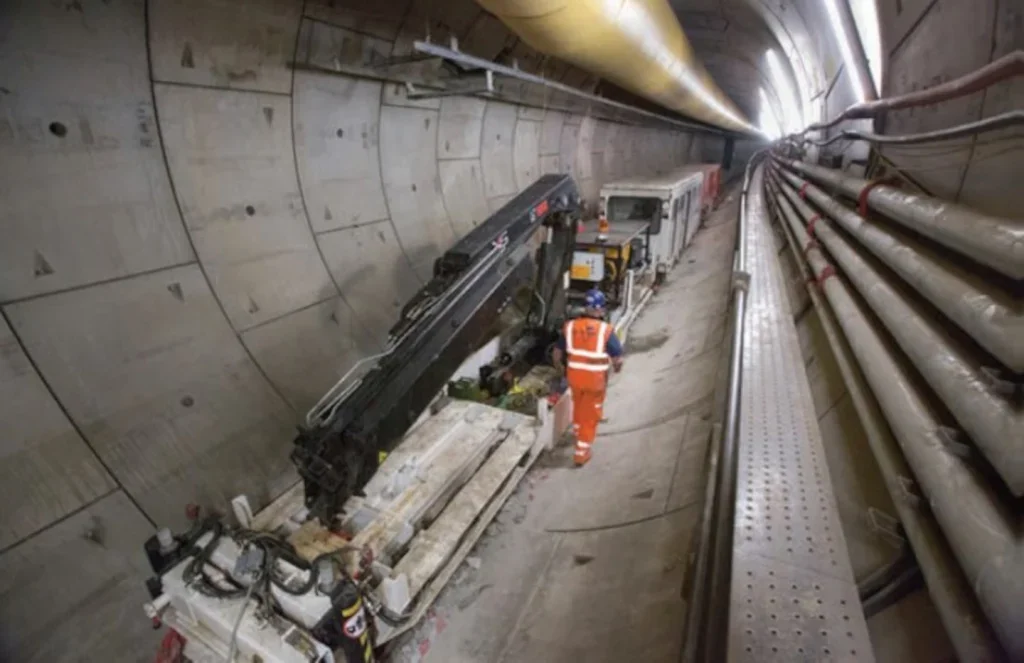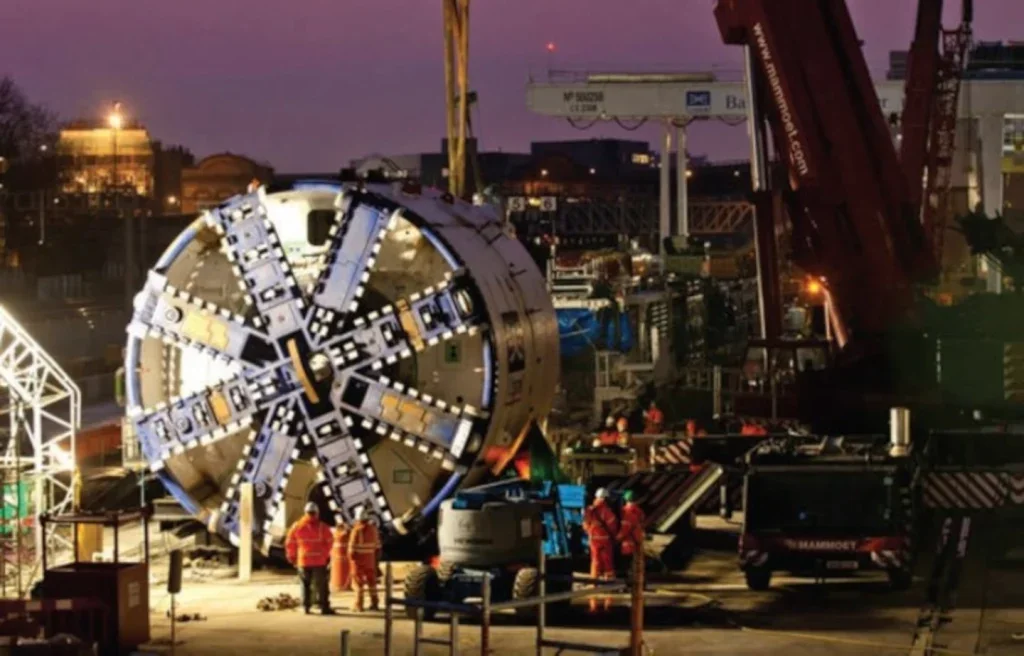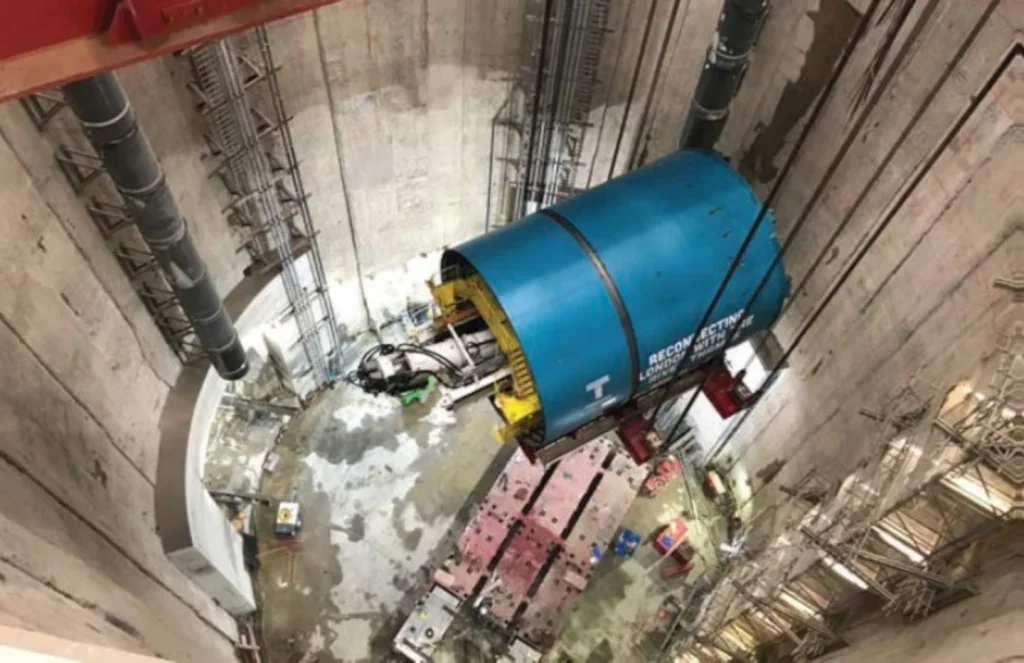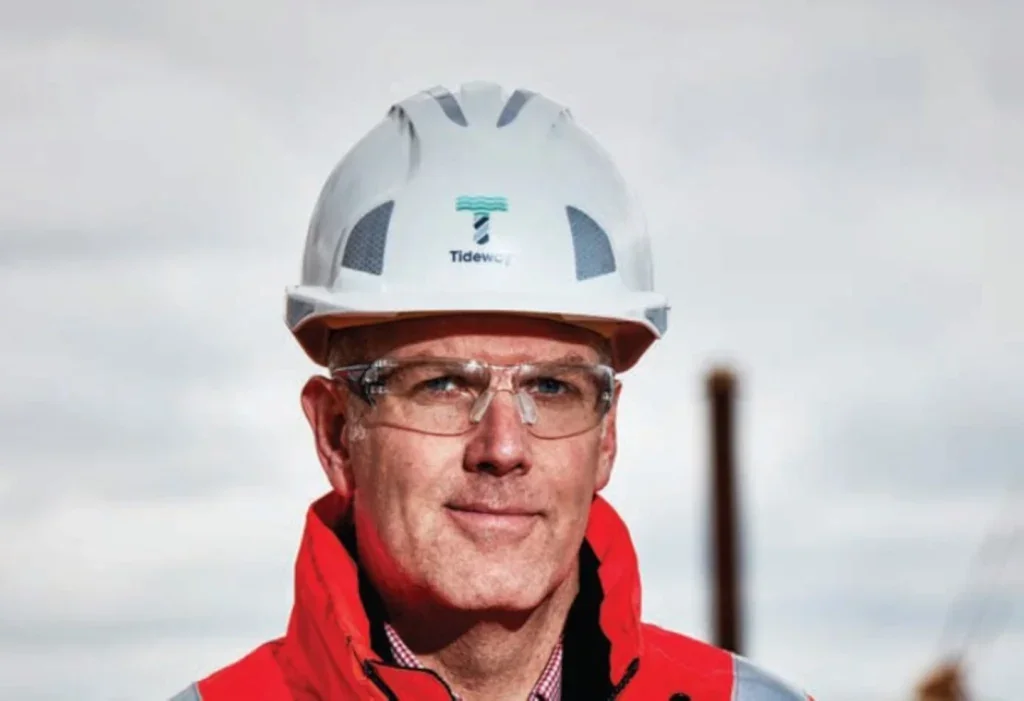
“I grew up in Harrow in northwest London. My dad ran a small building company – small scale domestic work, but he took me to his sites and I drew up some of the schemes for him, and the building trade was part of my growing up. And there were model railways, technical Lego – all of that. I went through A-Levels enjoying maths, I liked technology, and that led to a civil engineering degree at Leeds.
“I have always enjoyed the outdoors – I did a lot with the Scouts – and so construction on a large scale, outdoors, was interesting. Understanding the environment, looking after the environment, that was in there as well – probably not so consciously back then, but still it was there.

“At Leeds I found structures particularly interesting, and also geotechnics – geotechnics because of the complexity, the nuances. It is a challenging subject. You can never simply plug numbers into an equation to solve a problem because there will be a lot of uncertainty to take account of. You have really got to think about what you’re doing. It’s not just following a code, it is proper understanding. There’s creativity there.
“In my last year at Leeds we did a module on engineering geology and spent two or three weeks studying tunnelling. I loved the way that tunnelling technology pulled it all together – you have the geotechnical problem but there’s a structural engineering problem as well, and you are tackling all of them to create a space for a highway or a road or a rail line. There was real purpose to it; you were integrating a whole bunch of subjects, and I loved that.
“On graduating I was applying for work in the industry and I applied to Halcrow amongst others. They gave me a choice of three options: there was the Highways team, the Bridges team, or the Tunnelling team. At the interview they gave me the opportunity to meet the tunnelling team, which was at Hammersmith. Alan Runacres was head of department, and I spent the afternoon with him, saw some of the projects the team were working on, the Jubilee line and the DLR extensions. I worked for Alan Runacres for the best part of the next 20 years. He was fantastic.
“Crossrail was one of the projects being developed at the time. I spent a couple of years in the office working on the design of that, and then a year on-site on the Jubilee Line extension, at London Bridge. That was really good experience of working with construction teams, working with the mining gangs, and understanding how stuff is really built. I learnt how you can support the construction process with engineering control but also provide support for the kind of pace that things have to move at, to solve problems and then move on. I really enjoyed the interaction with the lead miner, the pit boss, the gang, and the practicalities of bringing them all together with the engineering.

“Then I had the opportunity to go onto the El Salam syphon tunnel in Egypt, which was a series of four 5m-diameter water supply tunnels underneath the Suez Canal. They were dug with a Herrenknecht TBM through very challenging ground conditions – there were quite a few problems in building that project, but it got built. I was there for just under six months, on the tunnel drives and the secondary linings.
“The Kuala Lumpur light rail project followed. Right through the centre of the city, with a series of TBM drives and underground cut and cover station boxes and ventilation and emergency shafts. It was a Resident Engineer role, with oversight of the design and construction, a good level of responsibility. I love taking accountability for solving things and making sure they are done right.
“Ground conditions again were very difficult. Very hard limestone was overlain by very soft alluvium, with the limestone top profile alignment varying a lot because of erosion in the past. One day you could be in a full face of hard limestone and then the next day you’re in a full face of soft alluvium. Culturally there was French- Canadian contractor, a Korean contractor, a Japanese contractor, Malaysian contractors; some had local designers, some had UK designers. Some just needed to discuss challenges in a straightforward way to agree methods and plans, some needed advice and coaching, and some needed directing – you just had to adapt your approach depending on the person, and that again was really good experience.
“Back in Britain, I worked on High Speed One. I was on the cut and cover tunnels to Ashford, working in a joint team with Arup and Bechtel, and that was cutting edge of design of cut and cover design. I also led the design checks for the North Down Tunnels, running finite element analysis, in 2D and 3D – I think we were probably close to the cutting edge of how to model spray concrete-lined tunnels at that time.”

Other projects followed, some successful, some less so: “The engineering was good but either the projects were running late or weren’t particularly organised, or were not financially as good as they should have been. It was frustrating. I thought: ‘There’s got to be a better way of managing these projects, and I’ve got to try to find out what it is.’ Which is curious because when I first joined Halcrow it was the technical stuff I liked. Managing projects and teams did not particularly motivate me then. But times change, and people grow.
“So I did a parttime Master’s degree in Project Management at Reading, which was constructionoriented, and at the same time I was managing the design for Dublin Tram. That was out of the tunnelling world: it was streetrunning light rail, and integrating the railway system with the tram stops and how that integrated with the road layout and the surrounding buildings and the urban landscape, and the power system, the signalling system and the drainage system. Everything had to be integrated, so it was a good project to be working on while I did the degree.
“After every week of the course I would come back to Dublin Tram with a ‘these are some things I want to try out’ list, and that was great.
“Project management is about people and systems: how do you organise all the bits that have got to come together. There’s a lot of iteration between things, particularly in design, so progressing work while keeping components coordinated is challenging. That’s part of what makes project management so interesting. Leading people through this is a massive part of the enjoyment.

“After that Halcrow won a project to design the Docklands Light Railway extension to City Airport. Because a lot of tunnelling projects were also railway projects I took on a role as project manager. Alan Runacres was project director. That was one of our biggest jobs; so to be project manager for it at that stage in my career was a big step. Alan put quite a lot of trust in me to do that, but he was always there as a support and I remember putting everything into it to make sure it successful.
“This was 3 kilometres of overhead viaducts, four new stations (three of which were elevated), all the railway systems and how they would integrate. Again it was design and build, so it was pretty high pressure and high intensity and again it was just great fun.
“And it was successful and on the back of it the same team won the extension to Woolwich Arsenal – which was back again into the tunnelling world with two and half kilometres of tunnel under the Thames. Throughout my career I have found myself working outside of tunnelling and then back in again.
“Our next big win was the Tottenham Court Road upgrade for London Underground. We had quite a few of the team from Docklands Light Railway, and quite a lot of the systems that we had put in place for that, and which I had got from the Project Management masters, we used as part of our bid for TCR Station Upgrade.

“We won that project because we went in there not just saying ‘this is how we’re going to do stuff’. Instead, we said, ‘We have all the management plans, this is the team, these are the people, this is how we’re going to manage it, this is how we’re going to control design, this is our quality plan, and everything is ready to go.’ That was our proposal and we were successful.
“A big part of our strategy was to co-locate the architectural team, the civil structural team, and the mechanical electrical team together with the client representative as well, and put them all in the same building. We set up an office for it in Centre Point [a well-known tower block in Tottenham Court Road]; and, that was the first time I’ve heard of co-locating teams in that way.
“It took a bit of courage in our partners to put their people in our office. That was quite a change in approach for some people but it worked, and it worked really well. We laid out the office in a way that the leads of each of the functions all sat in one group. Each of their functions radiated out from that hub, so that the team members who would naturally talk to each other could still do so, all the tunnelling team members would talk to each other, and all the structural team members; but it also made sure that all the different disciplines would interact as well; it built those relationships, and it worked really well.
“We got the whole design, from basic concept to contract documents, produced in just 18 months including all the approvals; it was remarkable how quickly we got the design done. And, part of that was just putting people’s desks in the right place next to each other.

“Having the client team with the design team was also critical to our success. That way there was no getting to the end of a stage then the client reviewing it and saying ‘we don’t like that, we want it like this.’ We worked together the whole way through.
“The next big project was Crossrail. When I first started work I had spent two years doing tunnel design and settlement analysis for it, then Crossrail paused, and now it was going back up again. I thought – ‘Right. I’ve got to be part of getting Crossrail built.’
“From a tunnelling point of view it was fantastically challenging. From a purpose point of view I understood from the work I had done for London Underground just how close to capacity the network was, and how essential it was to have Crossrail to relieve that. And it was my own home city.
“So I was in there as the chief tunnel engineer. I was setting up standards in a way that work; reviewing the designs as they got designed, steering them, guiding them to make sure we had good practical designs that were cost effective, easy to build, achieved what was required, and were safe. That was hugely complicated. There are listed buildings, other tube lines, critical services, water supplies, sewers, power cables all around you; so building it in a way that controls ground movement and protects all that stuff was a big part of the design process and the specifications.
“When it became clear that design was progressing in the way it needed to progress, the next challenge was: ‘how do we then convert this to getting it built?’ The programme of how the stations and the tunnelling all fit together was very challenging; and, one of the issues when I first started looking was that the programme was dependent on the stations at Bond Street and Tottenham Court Road.

“The stations had to be done before the tunnels came through; but to be able to build the stations you have first to create the ticket halls. To be able to do that you have to demolish buildings and to divert some utilities; and, to do that you have got to get Party Wall Act agreements from local building owners, and get the utility companies to do their utility diversions. So you are in their hands, and the utility companies are going to need to get traffic permits, so they are in the hands of the traffic authorities. You are in the hands of so many third parties and any one of them can delay you. It was clear that this was a massive risk to the programme.
“So I was looking at how we could bring it back into our own control, and it was obvious that the better way would be to drive the TBM tunnels through first and then enlarge the platform tunnels and ticket halls around them. That was a change from the plan that was already on the table. It meant that the schedule was much more robust because we would control the TBM and the tunnel coming through and were much less dependent on all these other parties. That way also gave better settlement control. It also meant that a huge amount of tunnel excavation for the stations would go out through the TBM conveyors, so could go away by rail rather putting lorries on the road. That’s got a big safety benefit and environmental benefit and a traffic congestion benefit as well; and, so this was the way forward.
“It had been made possible because we had procured the tunnel contract and the station contract with the option to combine them in the same package. That was one of the big things that made a difference to how Crossrail was delivered.
“The big regret about Crossrail is the fatality. Rene Tkacik was killed on one of our sites when freshly-sprayed wet concrete fell on him. The impact that had on Rene’s family, his wife, his daughter… it’s just too painful; and the effect on the team, on his colleagues was horrendous. The accident happened in an exclusion zone with controls in place, but after the event the industry came together and we looked at what we are going to do to further improve the way we build to make sure that never happens again. A higher standard was applied to how exclusion zones are managed, and the controls around this, and this quickly became industry standard on Crossrail and other major projects since. It is now established practice in sprayed concrete tunnelling.
“I cared deeply about health and safety before then – ultimately the greatest responsibility we have is to care for our team. However, going through that experience further reinforced just how important it is, and just how easy it is for someone to get hurt. You have got to drive a level of excellence so that people stay safe even when things don’t go fully to plan.”
The Crossrail tunnelling was coming to an end and the next big project in London was Tideway.
“I joined it because it was a big challenge with real purpose. Over time it was one of those projects where you just see the strength in the purpose of what we are building, and the value this is going to provide environmentally.
“As I have said, I enjoy being outdoors and appreciating nature and ecology and world we live in. Tideway was that exactly: it was the project that makes you think – ‘This is why we do what we do. This is why it is just so important.’

“We had this thing on Tideway that we wanted to be transformational in our health and safety approach: we were there to build Tideway right, build it safely, and to leave a legacy of a safer industry because of it.
“I genuinely think we have done that. The Tideway Health and Safety record was very good, and a lot of the approach that was developed on Tideway has gone out on HS2 and on various other big projects; so you could really see the leverage from it. This included our immersive interactive induction to really embed the culture from Day 1, our approach to sharing best practice and recognising it, and our truly collaborative approach to driving excellence.
“At Tideway the teams we had were great: the design teams, the construction teams, they were doing really good work. A key process we introduced was that before we started any major work on site, or before we started the next stage of any safety-critical high-risk activity, we would do a joint readiness review. Collectively as a team, we would go through design, planning, health and safety, consenting, temporary works and ask ‘Are we happy that this is all done right, that it’s all safe?’ That was done in a very collaborative way, in a way that was drawing on the experience of all the teams and that ensured we knew how to support each other.
“I always saw my role as programme director as being there to do things that were needed to lead delivery, but most of the time to support the teams who are doing some really good work; and where there were challenges to help to support the team in resolving those challenges.
In 2023, the BTS awarded him the James Clark Medal for services to the industry.
“Somehow, in amongst all of that, the BTS decided to award me this medal. I guess I am like all the other colleagues who have medals in that we all wonder what we have done to deserve it as everything we achieve is through the skill and dedication of a much wider team. I am very grateful.”
Then, in 2024, after thirty years with Halcrow/ CH2M /Jacobs, he left. Alder is now with Anglian Water. Was there a reason for the jump?
“There was. Tideway was getting to the point where it was year or so away from finishing. I thought, ‘If I stay here till the end, then I am in the way of some of the team taking more responsibility, someone else taking over as Programme Director and having the opportunity to lead. So it was time for me to leave Tideway to allow others in the teams to continue to grow and develop.
“I had got to the point where there’s only so much more stuff I can build in my career, and where the real value I can give is continuing to grow the team and develop people, so that they then carry on and take all that experience on board and build far more stuff than I can ever build. The legacy is development of people.
“So, I stepped away from Tideway and took a corporate role with Jacobs looking after their major programmes team. Jacobs is a great company, I’ve loved working for them; and there was a project we were working on for Anglian Water that was challenging but also has a really big environmental purpose. It is about water supplies for the eastern side of the country and making it sustainable. A lot of the water supply in the east of England is from groundwater abstraction, and that is having as significant detrimental effect on ecology in the rivers and streams that pollution does. Pollution is really important but actually not having enough water in the stream is worse still.
“So Anglian Water is building a strategic water pipeline that is the first stage of a grid system to connect up the whole of the water system from North Lincolnshire to Essex, so that the more sustainable water supplies in the north can be brought across to the south and east. So it is a good purpose, with a company that has adopted good values. Earlier this year I left Jacobs to join Anglian Water full-time to lead this interconnector pipeline programme and our other major infrastructure projects.
“I am also supporting the Bartlett School of Sustainable Construction. There’s a parallel there with health and safety. Key is the way we have embedded health and safety into engineering so that it is completely part of how we plan, how we design, how we work and build. Safety is an integral part of this now, it is not an add-on any more. We’ve got to get sustainability to the same stage. When we make decisions on how we plan, how we design, how we procure and operate – we need to make sure that sustainability is embedded in that right from the very start, at every stage from thinking about the project onward.
“Bartlett is part of UCL, University College London, and has a MBA in major infrastructure. I speak at a couple of the modules, on subjects like leadership and purpose, social value, how you deliver value through projects, and major programme management. This is all part of giving back to the industry and helping to set up the next cohort of major programme leaders.
“I do a fair bit of work with ICE as well, because one of the things that got me into civil engineering was a three-day experience thing for 6th Forms, where they took you to various projects and showed you what civil engineering is all about. When I was at that age I went on it and it really cemented the choice for me so I always felt it’s good to give back.
“And, I’m still a Scout Leader in my spare time. I think I learned a lot about leadership when I was in the Scouts. You’ve got a bunch of young people you are looking after and you’ve got to make sure that whatever you are doing, whether it’s going for a walk or some other activity, that you achieve what you set out to do, that everyone was looked after, that everyone was safe, that everyone had fun, that you have been encouraging the people who are really good at stuff, helping the people who are not. There are all kinds of courses and books, and you learn from colleagues and you see other leaders in the industry, and all of those are valuable; but I think Scouts is where I first learned leadership.







